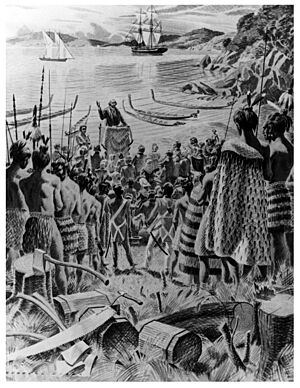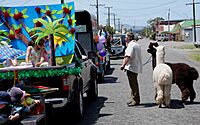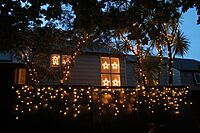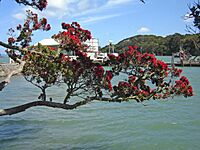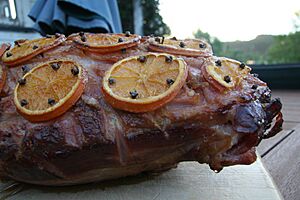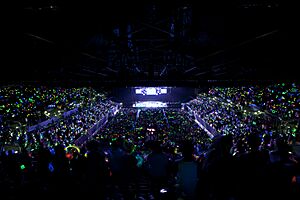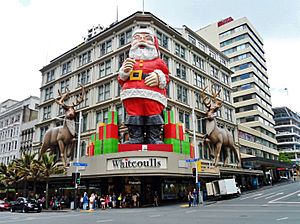Christmas in New Zealand facts for kids
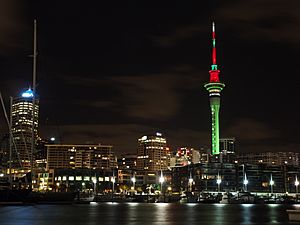
Christmas in New Zealand is a special time, blending old traditions with a unique summer twist! Because New Zealand is in the Southern Hemisphere, Christmas happens during the warm summer months. This means many celebrations take place outdoors. Think barbecues, picnics, and fun trips to the beach!
New Zealanders enjoy delicious summer foods like fresh fruits, vegetables, local meats, seafood, and the famous pavlova dessert. You'll also see beautiful Pōhutukawa trees, known for their bright red flowers, alongside traditional Christmas trees. Many people attend church celebrations on Christmas Eve and Christmas Day, singing carols in both English and Māori.
Christmas, called Kirihimete in Māori, became a popular holiday in the late 1800s. Today, Christmas Day and Boxing Day are both public holidays in New Zealand. People from all backgrounds celebrate Christmas, making it a joyful time for everyone. Christmas Day is one of the few days when most shops and businesses close, allowing families to spend time together.
Contents
The Story of Christmas in New Zealand
How Christmas Began
Christmas celebrations arrived in New Zealand with missionaries in the early 1800s. The very first recorded Christmas service happened in 1814. An Anglican priest named Samuel Marsden spoke to about 400 Māori at Oihi Bay. This special event took place in the Bay of Islands, after chiefs Te Pahi and Ruatara invited him.
Growing Traditions
Over time, different groups of settlers brought their own Christmas customs to New Zealand. English and Irish settlers, for example, shared their unique ways of celebrating. Scottish settlers initially did not celebrate Christmas as much. However, by the late 1800s, Christmas became a holiday enjoyed by almost everyone in New Zealand. It was often a quiet, family-focused day for many years.
Christmas Becomes a Public Holiday
Christmas Day became an official public holiday after the Bank Holidays Act 1873. This meant many people got the day off work. Later, the Industrial Conciliation and Arbitration Act 1894 made sure all workers had a day off for Christmas. The Public Holidays Act 1910 officially made both Christmas Day and Boxing Day non-working days. This helped make Christmas a widely celebrated time for all New Zealanders.
Festive Sights: Decorations and Symbols
Unique New Zealand Christmas Symbols
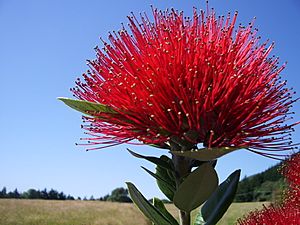
New Zealand Christmas decorations mix traditional winter scenes with local nature. You might see native plants, ferns, and flaxes alongside classic Christmas flowers like mistletoe. Stars and angels, important in the Christmas story, are also popular.
A very special symbol is the Pōhutukawa tree. It blooms with bright red flowers in December, making it a natural Christmas decoration. Because of its festive look, the pōhutukawa is often called the New Zealand Christmas tree.
Lighting Up Homes
Many families love to decorate the outside of their homes. These displays can be simple or very fancy, with hundreds of lights! You might see Christmas trees, Santa Claus, reindeer, or nativity scenes. Some areas are famous for their amazing light displays, attracting many visitors. Even though summer days are long and it stays light late, people still enjoy these sparkling decorations.
Delicious Christmas Food
Summer Feasts
Families traditionally gather for a special Christmas lunch. While eating a formal meal indoors is still common, barbecue lunches have become very popular. In 2019, about 43% of New Zealanders enjoyed a BBQ for Christmas lunch! Traditional cooking methods like hāngī, umu, and lovo are also used for Christmas meals.
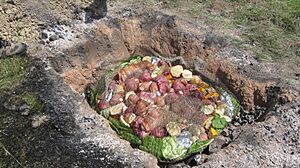
Christmas lunches often feature hot meats like lamb and ham. Root vegetables such as potato and kūmara (sweet potato) are also popular, along with a variety of fresh salads. Because of the warm summer weather, serving cold meats and seafood has become a favourite choice.
Sweet Treats
For dessert, you'll find a mix of traditional British sweets and local favourites. Classic desserts include Christmas cake, Christmas pudding, fruit mince pies, and trifle. A truly New Zealand dessert is pavlova, often topped with fresh summer fruits like strawberries, raspberries, or kiwifruit.
Parades and Music
Festive Parades
New Zealand hosts several fun Christmas parades. A very popular event is Auckland's Santa Parade, which travels down Queen Street. This parade features many colourful floats and marching bands, drawing huge crowds every year. It usually happens in late November, kicking off the holiday season.
Christmas Music Events
The tradition of Carols by Candlelight is also very popular. In cities like Auckland and Christchurch, large outdoor concerts called Christmas in the Park are held. These events bring communities together to sing carols and enjoy the festive atmosphere. Many original and adapted Christmas songs have been recorded in New Zealand since 1949.
Religious Observances
Christianity is the most common religion in New Zealand. Many people celebrate Christmas for its religious meaning, while others focus on family time. In a 2006 survey, about two-thirds of people said the best part of Christmas was spending time with family.
Churches across New Zealand hold special services on Christmas Eve and Christmas Day. These celebrations often focus on the message of "love, grace, peace, and salvation" that came with the birth of Jesus. From 2009 to 2013, St Paul's, Auckland hosted a large carol event called GLOW Carols by Glowstick at Auckland's Vector Arena. Around 10,000 people attended each year.
Christian groups also help those in need during Christmas. For example, in 2022, Auckland City Mission planned to give out 10,000 food parcels and thousands of presents. This support helps families who need a little extra help during the holiday season.
Christmas Shopping Season
The weeks leading up to Christmas are the busiest shopping time in New Zealand. In the six weeks before Christmas 2019, people spent about $8.6 billion through the Paymark network, which handles many electronic payments. On Christmas Eve 2019, the Paymark network processed nearly 200 transactions every second during peak times!
Black Friday Sales
Black Friday sales started becoming popular in New Zealand around 2013. Retailers adopted these sales to compete with online stores from other countries. By 2015, big stores like The Warehouse, Noel Leeming, and Harvey Norman offered Black Friday deals. By 2018, more stores like Farmers, JB Hi-Fi, Briscoes, and Rebel Sport joined in. In 2019, Black Friday spending even surpassed Boxing Day sales for the first time.
Christmas on TV
Since Christmas happens in summer, watching a lot of television is not as big a tradition as in some colder countries. Most regular TV shows take a break from mid-December until mid-to-late January. Until October 2025, no advertising was allowed on New Zealand television or radio on Christmas Day. This rule also applied on Good Friday and Easter Sunday.
TVNZ 1 broadcasts the Royal Christmas Message at 6:50 pm. This message has been shown on television since at least 1961. A 2006 survey found that 20% of people thought watching the Royal Christmas Message was important.


